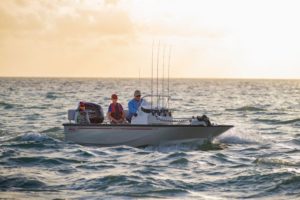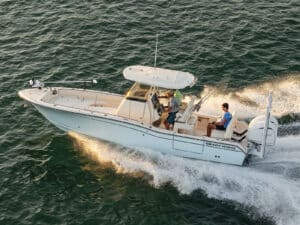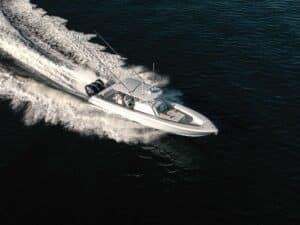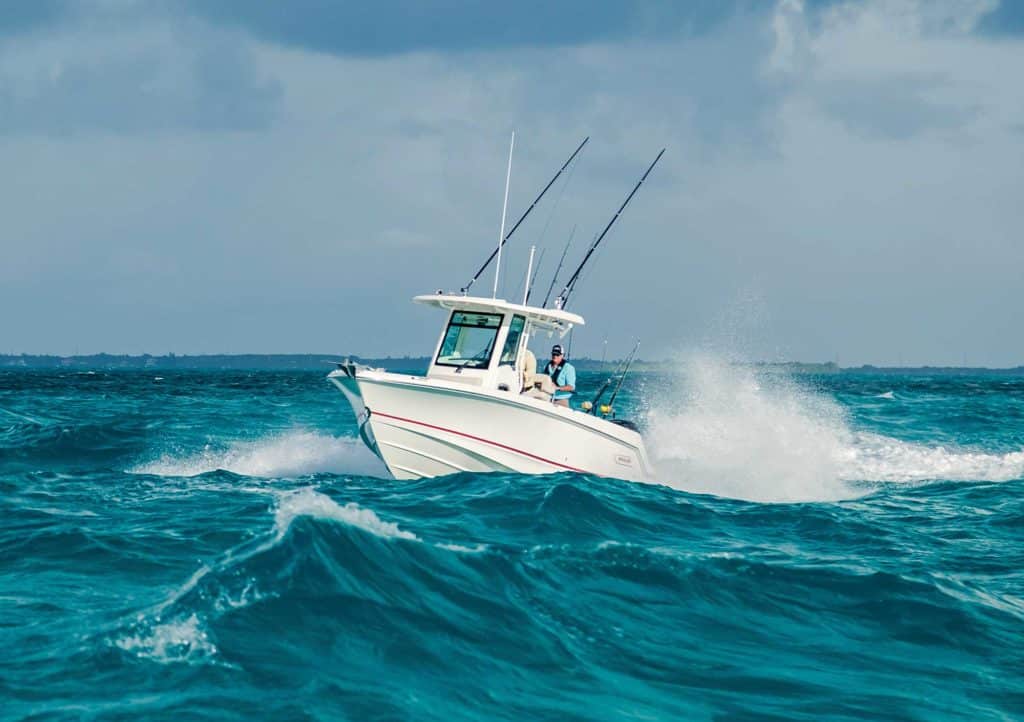
We had put several miles astern en route to Santa Catalina Island, 26 miles off the Southern California coast, when seas turned nasty, heaved our way by a distant yet powerful Pacific storm. Our westerly heading had turned this fishing trip into a hate mission.
“Hang on, we’re changing course,” I barked to the crew, then turned the 22-footer about 45 degrees to port, and began quartering the seas. We now met the waves at a less-severe angle, slicing diagonally over the rollers, for a smoother, faster ride. When we reached the lee of the island, I turned back to starboard, putting us on a course to our fishing spot.
I call it tacking — like a sailboat — and it’s just one of the following five techniques I have learned to help smooth the ride.
Up-Sea, Down-Sea
Running a course that points the bow into the wind and waves might run contrary to the concept of smoothing the ride. But the idea is to work your way into the prevailing wind in the morning, when breezes often are light and seas small. This plan is particularly well-suited when offshore fishing, where most of your time is spent trolling at a relatively low speed. As we will discuss later, the lower the speed, the smoother the ride in just about any sea state.
At the end of the day, when the winds are often gusty and the waves whitecapping, your course back to port will be down-sea. I call it a downhill run, and it’s far more favorable than banging your way back home uphill against a raging head sea. You can run a lot faster and smoother with the waves behind you.
Trailer boaters possess the advantage in pulling off this strategy because they can tow their boats to launch points that grant the best angle to run the up-sea, down-sea course to and from their target fishing spots.
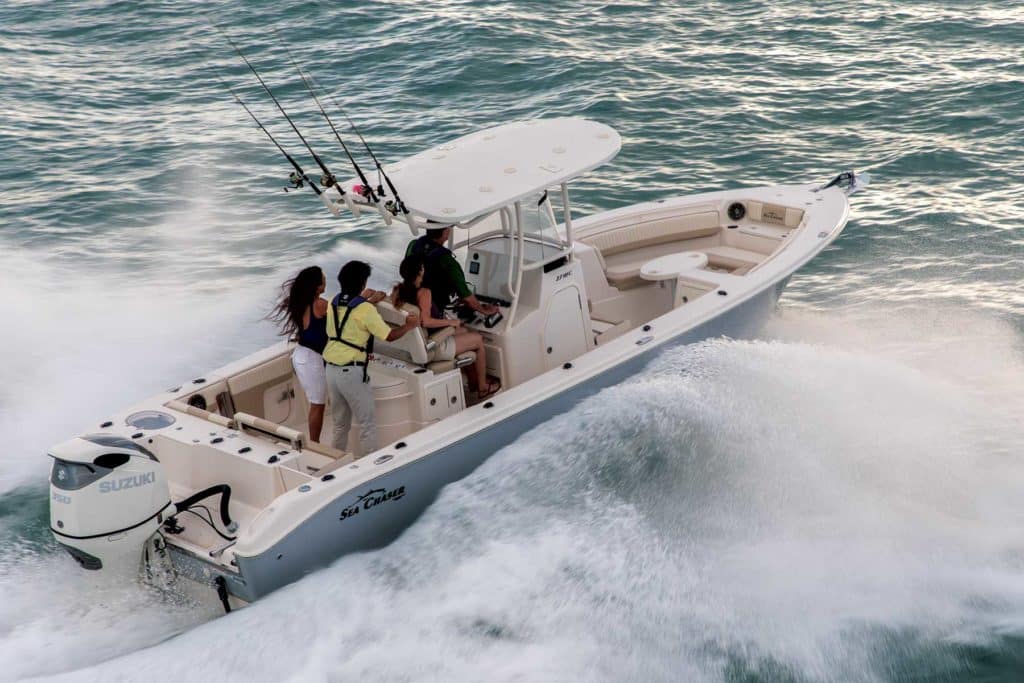
Nose Down
Sometimes you can’t escape the uphill run. Maybe the wind shifts or you need to run a circuitous route with one or more legs that face steep waves. When this occurs, you can smooth the ride by lowering the bow so the boat’s sharper forward entry knives through the waves versus pounding over them with the obtuse midsection of the hull.
The manner in which you lower the bow hinges on the behavior of the hull and sea conditions at any given time. Generally speaking, it requires adjustments of the trim tabs, outboard trim, and boat speed to fine-tune the ride and maximize the smoothness factor.
Deploying the trim tabs downward forces the entry downward. Trimming the outboard(s) in does the same thing, but with the trim tabs down, you will probably need to trim the motor(s) out slightly to maintain lateral stability while underway. Otherwise, with motors tucked in all the way, hulls tend to lean excessively from one side to the other when tabs are substantially deployed.
Once you have created a running attitude that allows the entry to cut through waves, increase the speed to see how fast the boat will run while still maintaining a comfortable ride. And be prepared to readjust all of these parameters when sea conditions change — as they always do.
Take Your Time
Sometimes the sea conditions and size of your boat prevent you from running at a decent clip without taking a beating, endangering crew or damaging the boat. This is when you need to take your time and slog it out.
There’s no shame in slowing down to keep your crew comfortable and prevent injuries from pounding waves and hard landings, no matter what sense of urgency you might have in reaching the fishing grounds or returning to port. It’s hard on the nerves — I know from experience — but once you set your brain on Neptune time, it’s easier to accept that you’re on nature’s schedule, not yours.
Going slow also gives you time to judge the waves, aim the boat toward the gentlest part of each crest, and jockey the throttle to ease the boat up and over the rollers — all steps that can result in a smoother ride.
Speed Up
In view of the previous discussion, increasing boat speed might sound like bad advice, but with some boats — not all — and in certain conditions, smoothness can improve as speed increases. Case in point: I was running across Florida’s Biscayne Bay late one winter afternoon, headed to Miami from Key Largo aboard a 23-foot Angler deep-V center-console powered by a single 225 hp outboard.
A stiff north wind and 2- to 3-foot rollers on the bow made for a bumpy ride at a moderate cruising speed. My co-captain, David Greenwood, product planning manager for Suzuki Marine, suggested I pick up the speed. “Let’s get on top of this stuff,” Greenwood said. “Punch it!”
I firewalled the throttle, and the boat literally levitated. At close to wide-open throttle, the hull’s lift allowed us to skip across wave tops at nearly 50 mph. Even with slowing down in the no-wake zones between the Rickenbacker and Venetian causeways, we made it to the Miami Sealine Marina well before dark.
Read Next: A Guide to Running Rough Ocean Inlets
The ability to generate a smoother ride at higher speeds hinges on sea conditions, hull design and boat size. For example, had the seas been a lot larger on that run to Miami, we might not have been able to bridge the waves with a 23-footer, no matter the speed.
Today’s center-console boats with advanced double-step hulls are particularly good at running fast and smooth in snotty conditions. The steps provide generous lift along the entire length of the hull, allowing such boats to more easily “get on top of the waves,” as Greenwood puts it.
Tack and Forth
While a straight line between two points is the shortest route, it’s not always the most comfortable. As described earlier, running directly into steep head seas can result in a pounding. In this situation, try steering off-sea in one direction for a few miles, then tacking the other way. Quartering the waves can smooth the ride.
One downside to tacking up-sea is more wind spray than if you meet the waves head-on. But that’s the price you pay for being a smooth operator.

